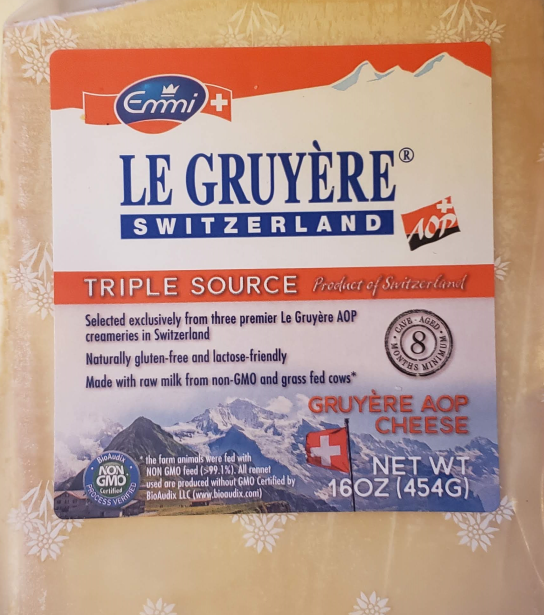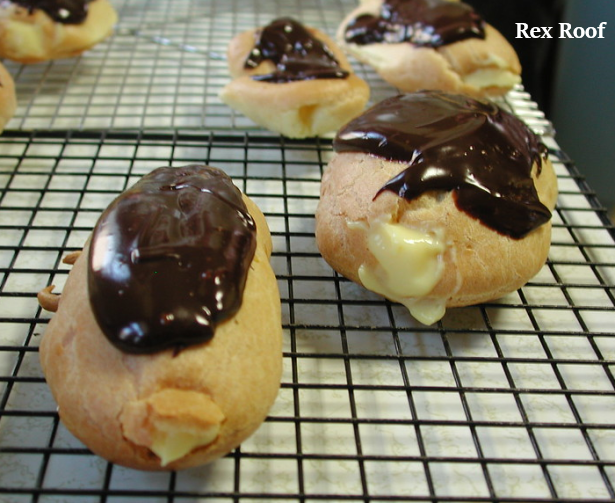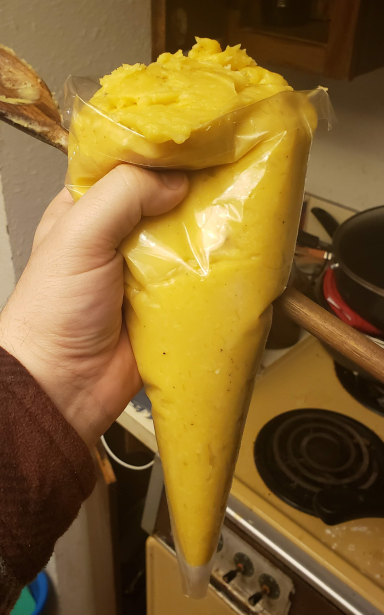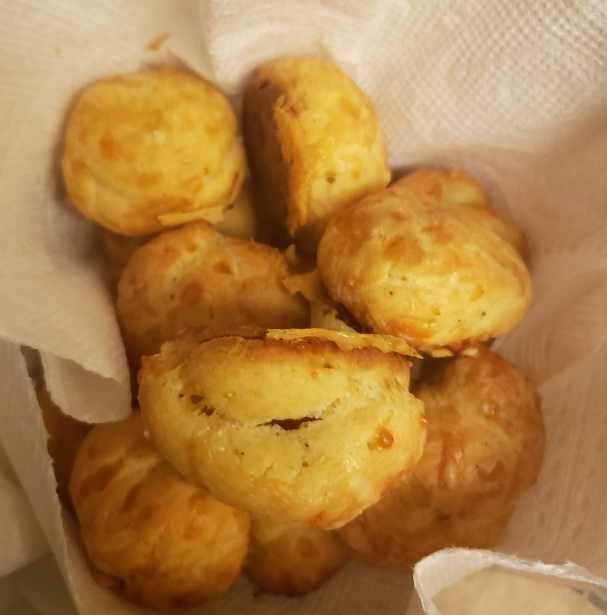KC 198 – Gougères

Why hello there, and welcome back to Kitchen Catastrophes, where the food’s not done till something’s burning. I’m your flambé foodie, Jon O’Guin, and today’s recipe is an amazing mix of easy and hard, quick and slow, fancy and…kinda dumb, as we explore a French appetizer with a versatile base, and I try not to end up with egg on my face. For everyone who wants the skip the journey and get straight to making their own, here’s the link. For everyone else, let’s pop open some Sancerre, and dish on Gougères.
A Confusing Hole of Nothing
That may sound somewhat bleak, but I assure you, this recipe isn’t all that difficult or frustrating. No, my complaint is with the history. I’ve mentioned MANY times on the site how frustrating it can be when you dig into the history of a recipe or the etymology of a word, and get back a shrug from history. It’s especially frustrating when the word is particularly notable. If I handed you a pair of boots and called them Sleestaks, you’d ask where the hell that word came from. As well you should, since the Sleestak are the villainous lizard-men from The Land of the Lost.
I would use their iconic screeches, but A: that would be hard to spell, and B: I watched Land of the Lost like, TWICE, so I have no idea what they sound like. For all I know, they speak perfect English.
Gougère (the singular of gougères), feels like one of those words. Like, in French, a gouge (meaning “a tool used for scooping out material”) is gouge. Like in gouging out a hole. That VERB is spelled basically the same. So, with this dish of little hollowed-out balls of dough, that early cooks probably would have SCOOPED INTO BALLS before baking, you would assume that the name basically means “little scoops”.
Fun fact: it doesn’t. Or at least, it might not, because no one knows what the fuck it means. The word just SHOWED UP. And my argument for the explanation doesn’t even make sense, because originally, they were completely fucking different! You know what’s in gougère? Cheese, dough, and seasoning. That’s it. You CAN add a little savory filling like meat or sautéed mushrooms, but the standard is as a little cheeseball. Kind of. Oh, did I not mention? This STILL comes in like, FOUR variants. Luckily, that bit’s pretty easy to explain: while the appetizer-sized 1-2” ball is one of the more common preparations, it CAN be served in other sizes, by just adding more dough. You can do like, 4-inch balls instead of 2, or you could lay out all the dough into a pie pan or ring. So, you can get a little cheeseball, a big cheese ball, or a slice of flaky bundt-cheeseball
Sometimes they look like bagel bites.
But over the centuries (the first record fo the recipe is in the 1300’s), the name has been used for some very different dishes. One recipe published in the late 1800’s used the name (or at least, one of like, 6 variations of the name) to refer to a flat disk of dough made with cheese, eggs, and breadcrumbs. Earlier recipes describe something closer to haggis, or a particularly inventive take on the Breakfast sausage, cramming bacon, eggs, cheese, meat, spices and herbs mixed with blood into a sheep’s stomach.
And the official summary of what its name means is “Look, some guy wrote it down in 1300, and we never asked.” The closest I have to any kind of lead (beyond the apparently false cognate of “little gouged ones”) is that the FRENCH version of Wikitionary says “hey, you should check out this other old spelling of the dish, which is a synonym of talmouse, another kind of cheese-filled pastry, whose name is apparently taken from Arabic according to French’s dictionary. Which, at least speaks to the enduring element of cheese in the dish, but even THAT doesn’t help things.
Because the traditional cheese for Gougère is Gruyère.
Here is some classic, TRUE Gruyère, as you can see from the AOP designation.
It’s also a brick you can buy from Costco.
And YES, THOSE WORDS DO LOOK SIMILAR. Hey, wanna know what makes them look MORE similar? The fact that the original version of the word was spelled with an I or a Y, not with a second G. Gouyère, gouiere, gouyere, ALL attested spellings. The only problem is, Gruyère, despite being a somewhat popular cheese in France, isn’t French. It’s Swiss, from the town of Gruyeres. Whose name is derived from the Gruyeres family, who are named after Cranes. Because in FRENCH, the word for crane is grue.
Also, and this is probably relevant, did I mention Gougère are mostly a Burgundian dish? Burgundy being the Eastern side of France. In fact, the former Dukes of Burgundy famously lost a battle to the Gruyeres family while attempting to seize . And the Dukes of Burgundy, in addition to controlling Eastern France, during the height of their power, controlled the entirety of Belgium, and attempted to seize the northwestern parts of Switzerland. I mention it only because, at one juncture, gougère were, according to Wikipedia, completely forgotten in France, and only really eaten in BELGIUM.
What does any of this mean? I have no goddamn idea, other than the vague idea that maybe gougères were originally supposed to be Gruyère tarts, but after the wars with Switzerland went bad, they changed the name a little to not piss off the nobles and remind them of how their dad/grandpa got killed losing a war.
“A bowl of "Your-Stupid-Dead-Uncle” Stew, Milord?”
Anyway, let’s talk about fucking cabbages instead.
The Rabbit Hole Gets Deeper
On Thursday, I mentioned that we were making cabbage pastries today. And that’s technically, and stupidly, correct. See, despite the earlier sheep stomach preparation, the MODERN take on gougère is pretty simple: it’s a savory, cheese-studded pate au choux dough. I see that didn’t explain much to many of you. Would this picture help?
Perhaps some éclair-ity, eh?
Pate au choux (which marks the point in the post where I have given up on diacritical marks, because pate has TWO of the fuckers) is a particular type of dough that is used in a lot of “fancy French” preparation. It’s the dough you use to make cream puffs, éclairs, Beignets, croquembouche (a tower of little dough balls, often stuffed with cream or other filling and bound together with caramel) and more. It’s one way to make Zeppole in Italy, and the basic dough for Churros in Spain.
And its name means “Cabbage pastry”, because the little balls it makes look like cabbages.
Are French Cabbages just more appetizing than American?
That’s it. That’s the heart of my ‘cheesy’ joke. Anyway, Pate au choux dough is kind of fascinating to work with, because, as you might have noticed from that list of things it’s used in, one of the defining characteristics of ‘choux’ products is that they have a LOT of space inside them. Big ol holes to be filled with cream, custard, caramel, wasabi, or other things. And what makes that interesting is that choux dough has no leavening agents. No baking powder, Baking soda, or yeast. No, it achieves that lift through a steamier little process we call…”Steam”.
Something to Choux On
Let’s actually walk through the process step-by-step, and we’ll cover how it works. The first step in making pate au choux is to boil some water and a whole stick of butter, along with salt and nutmeg. The seasonings get added now because we want the salt to dissolve into the dough as a whole, and we similarly want to ensure the nutmeg is finely distributed.
This was meant to be a cute little smiley face, but the shadows are sharper than I thought they were, so the butter smile feels somewhat ominous.
Now, that picture is clearly of more than water and butter. And that’s because I was being a bit bougie, and added some milk to the process. This will result in slightly richer choux as well as one that browns a little better, but it does make the dough a little more finicky, by lower the amount of pure water involved. Because the next step is to just dump all your flour in, and stir the CRAP out of that bowl.
What’s going to happen is that the hot water is going to super-charge the flour’s ability to absorb water, and even overload some of the flour particles, causing them to burst and add more starch to the mixture. The flour is going to TRY and form a dough, and will succeed, but the excess water is going to cause it to cling to itself, often forming a ball.
This is, in theory, a ball.
IN a real “imagine a spherical cow” kind of sense.
You then stir this for just a while longer over heat, until a “crust” forms in the pan. This shows that you’ve cooked out some of the excess water, and the mixture is leaving particles behind. Now comes the next step: adding the eggs. But first, take your pot off the heat. You want this to cool down before you start adding the eggs, for a pretty simple reason: if the dough’s too hot when the egg hits it, it’s going to start cooking immediately, and you’ll get little streaks of scrambled egg in your pastry.
Why are we adding eggs at all, you may ask as you wait for your pan to cool. Well, the eggs are going to add MORE moisture, as well as a protein structure. They’re going to help encapsulate the water in fat and protein, and protein LOVES to stick together. That’s what gluten is, at its core: wheat protein. Anyway, once the pot has cooled, you add ONE whole egg, and stir until it’s basically completely absorbed, and the dough looks like it did before the egg went in. And then you repeat the process 3 times.
This is NOT a ball, in theory or in praxis.
Let me tell you, this is the part that sucks. I don’t know what it is, maybe just the spoon and pot I used, but there was something immensely frustrating about the way that the dough would just kind of smash the egg and smear it around the pan for the first couple stirs, getting weirdly easy to stir, and streaking out. It just made my arm move in jerky movements, which, given the amount of force needed to stir this lump of dough and force the egg into it, wasn’t very fun. EVENTUALLY the mixture came together each time, and, as a point of order, THIS is pate au choux dough. IF you piped this stuff out and baked it, you could make cream puffs, éclairs, or any of the other fancy stuff I mentioned. But WE want to make something more savory, so we’ve got another step.
We Get Cheesy
As I noted back in my “I hate this name and the history of France” segment, Gougère are traditionally made with Gruyère cheese. Which, as it happens, is one of my mother’s FAVORITE cheeses. (A somewhat strange announcement, since I can’t think of any traditionally gruyere-dependent dishes she likes. Like, she hates French Onion Soup, she doesn’t really eat Croque Monsieurs, she only took a couple of these guys, but whatever.) Because of this, we have multiple blocks of it in our cheese drawer, so I just snagged 6 ounces of it for this recipe.
Shown here like Enron evidence.
I grated it in two sizes, one ‘regular’ and one ‘fine’, because I wanted there to be both cheese throughout AND more prominent “veins” of cheese. I don’t know if this changes much, but I thought it was a nice touch.
Speaking of which, I actually did this BEFORE I started the dough, because you need to get this into the dough while it’s still warm enough to melt and incorporate. I also preheated the oven long before this, so you should do that too. THEN, add your grated cheese, as well as 10 grinds of fresh black pepper, and a SECRET WEAPON to the mix.
Is it a chemical weapon, Jon?
We agreed not to make those anymore in that treaty, remember?
This secret weapon is Trader Joe’s Umami Powder, which I really just added because A: it allowed me to really avoid any kind of accusation of copying recipes (which I didn’t, since this is a bastardization of TWO recipes I found), and B, I thought it a fun thing to add to punch up the umami flavor of these cheesy bites, since, as we noted earlier, sometimes these things come stuffed with mushrooms, and one of the key ingredients in this mix is mushroom powder. If you don’t have it, don’t add it, or go with some other salty blend you think might be interesting.
A Piping Mad Mixture
Once the cheese is mixed into the dough, it’s time for the second hard part: the serving. Specifically, The instruction I have say to pipe out the dough onto parchment paper lined baking sheets. And since I strive to avoid baking on the site, I have not needed to deal with piping bags in QUITE some time. Though, as I alluded to last week, I did work at a bakery for a time, so I do know HOW to use them. So you scoop all of your dough into the piping bag, and run into a problem.
Mo Dough, Mo problems.
See, if you haven’t used one of these, the way they work is you seal the top, and squeeze the bag to force the contents out the bottom, which can be cut to different sizes, or fitted with a tip to create certain shapes or designs. This is just a ½” (1.25 cm) wide hole, to make 1” wide balls. BUT, since I have more dough than I should, I have to do most of the first sheet of these by scooping out dough using a spoon, to get enough space to twist the bag shut at the top. (Actually, I could have just emptied the bag into a gallon zip-lock, and cut THAT corner, but I was resolved to try this way.)
I had a fair bit of trouble trying to set-up/force the dough out the bottom. So much so that my mother decided to investigate the copious profanity emerging from the kitchen. (While not actually all that difficult, I had, in classic Catastrophes form, started this recipe an hour and a half before I had to be somewhere, so delays were starting to cut into my “we’ll be there on time” safety barrier.) She pointed out that I had cut a hole closer to a third of an inch, which, with such a thick dough, was probably a hefty portion of my problems. As such, she took the bag, snipped a larger hole, and proceeded to lay out the second baking sheet in half the time it took me to do the first one.
We sprinkled one of the sheets with extra cheese, as a couple recipes suggested it for a more interesting texture and greater cheese flavor. After baking for 20-25 minutes, they turned out…pretty impressive.
Nate called them “those biscuit things you made”, which, sure, I get the look.
The biggest issue we had is that the bottoms of our bottom rack of gougère overcooked, just BARELY falling short of outright burning. And the bottom rack was the extra cheesy rack. But the results we got were warm, cheesy, and impressively flaky.
“Steam power, my boy! The cooking technique of the future!”
They actually tasted moderately better, in my estimation, after a couple hours of cooling, when you could really FEEL the flaking of the crust, and those veins of cheese, as well as get a little more of the eggy flavor. I gave it to my mother, who ate several, as well as pre-show snacks for my play’s opening night, where they were praised by several performers, and even Nate had a couple. Out of the 40 or so we made, they were all consumed with a day or so. They’re a nice little appetizer, and I think they’d do particularly well as a brunch option if made the night before, where their eggy dough and salty cheese would fit well into the overall flavor palette of the meal. All in all, while a somewhat rushed and momentarily frustrating experience, I’d honestly say they’re a pretty solid appetizer option. In terms of “number of items per hour of effort”, they have a solid ratio, and I bet someone with more experience won’t have the same irritations I did stirring the eggs in.
No links for social media or patreon today, as I’m feeling a little under the weather. You’ll have to rely on the links up in the top navigation if you want to check us out.
THURSDAY: I DON’T KNOW. MAYBE WE’LL TALK ABOUT PIPING BAGS AND BAKERY STUFF? I’VE REFERENCED IT TWICE NOW, SO MAYBE I CAN SPILL MY “TRICKS OF THE TRADE”. (I HAVE VERY FEW OF THEM. I WAS EMPLOYED THERE FOR MAYBE 2 MONTHS.) WAIT, NO, I SAID WE WERE DOING A STATE OF CATASTROPHE. WE’LL DO THAT NOW, AND HANDLE THE BAKERY THING ANOTHER TIME.
MONDAY: SIMILARLY UNPLANNED. A WEEK OF TECH REHEARSALS, AND A LOT OF RUNNING AROUND THIS WEEKEND MEAN I’M BEHIND IN MY PLANNING. IT WILL PROBABLY BE…SOUP? OR MAYBE SOMETHING VEGGIE BASED/MINIMALLY MEATY. SINCE THE NEXT WEEK WILL BE SUPER BOWL FOOD, AND I HAVE A DOUBLE-MEAT DISH PLANNED FOR EARLY FEBRUARY. THOUGH I COULD MOVE IT UP…
Now we're at the!
Recipe
Gougères
Makes 40-50
Ingredients
6 ounces of Gruyère cheese (or other hard, salty cheese such as Comté or Parmigiano Reggiano), grated (if possible, 3 ounces grated, and 3 ounces FINELY grated)
1 stick of butter, cut into chunks
½ cup water +1/2 cup milk (or use 1 cup water)
¾ tsp salt
A pinch of nutmeg
1 ¼ cup all-purpose flour
Freshly Ground black pepper to taste
¼ tsp Trader Joe’s Umami Powder, or other seasoned salt product. (optional)
Preparation
Preheat oven to 400°. Bring butter, salt, nutmeg, and water/water-milk combo to a boil in a medium saucepan, stirring until butter is melted. Remove from heat, add flour, and stir to combine. Lower the burner to medium heat.
Cook mixture over medium heat, stirring vigorously with a wooden spoon, until mixture pulls away from sides of pan and forms a ball, about 2 minutes. Continue to cook, stirring vigorously, until a dry film forms on bottom and sides of pan and dough is no longer sticky, about 2 minutes longer.
Remove pan from heat and let dough cool slightly, about 2 minutes. Mix in whole eggs one at a time, incorporating fully between additions. Mix in 5 ounces cheese, pepper, and additional seasoning.
Scrape dough into a piping bag fitted with a ½” round tip (or, use a plastic bag with a ½” opening cut diagonally from 1 corner). Pipe 1” rounds about 2” apart onto 2 parchment-lined baking sheets. Sprinkle rounds with remaining ounce of cheese.
Bake in pre-heated oven for 20-24 minutes until puffed and golden brown. You may wish to swap the sheets half-way through, depending on your oven heating element, and if the bottoms are browning too quickly. Serve hot, warm, or room-temp.



















